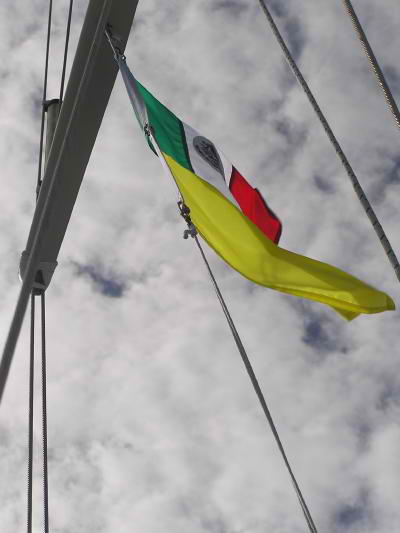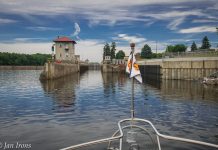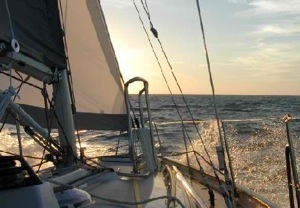For those new to cruising outside the US, the concept of checking into foreign countries, especially those that don’t speak English, can be very intimidating. I remember, it was for us! But after many check ins & check outs, we know just to reserve a day of officialdom for the task and enjoy being a guest in their country, cruising to new adventures otherwise impossible!

Cruising in other countries can be symbolized by the bright yellow quarantine flag. The first thing you will do as you approach a new country is to hoist the bright yellow quarantine flag up under the courtesy flag from that country on your starboard spreader. This signals everyone, including the country officials that you are a new arrival and you need to process your checkin. Every country has different procedures and often the procedures in the same country changes from week to week and port to port. Start the process by flying the quarantine flag and the correct country courtesy flag. There seems to be some debate about whether it’s necessary to spend the money to get the country’s courtesy flag. If you aren’t flying one, some countries force you to buy one at inflated prices from the officials. We’re fairly certain this is a separate money making enterprise, but save yourself the trouble and get the courtesy flag ahead of time!
Don’t be surprised if you are told to go to one office and then when you arrive (and sometimes wait for hours for someone to arrive and unlock the door), you’re told that no, you had to go somewhere else first. But unfortunately that other place, in a different location in town, or sometimes in the next town, is now closed and you’ll have to either wait or come back the next day. Aaaarrrgggg!!! And the smaller the port you’re trying to check in or out of, the more likely you’ll encounter these frustrations. Remember, it’s important to be legal, but it’s also important to keep your cool — hard sometimes when you’ve just walked a couple miles in the searing heat only to find out that you have to go somewhere else first.

At the end of the day (or days depending), it will all be part of the cruising adventure, so treat it as a game and play it nicely!!! At the end of this post, I’ll offer a few comments on countries we’ve checked in and out of, but keep in mind, these things change daily, so my comments may or may not be valid when you check in. The best way to get the update is to ask cruisers coming the other way what was expected at the port you’re planning to visit. You can ask on the morning SSB net or just dinghy over and ask in person.
Our first checkin in a foreign country was Isla Mujeres, Mexico. Unfortunately, as in most countries, there is no clear information regarding the “rules”. We heard from the marina that we would need to go to Migracion (immigration) first, then to the Capitania del Puerto. Unfortunately, there were “new laws” published the day before we arrived and no one knew how to implement them — seemingly it’s happening all over again because in June 2011 there were more new immigration laws and once again, the reports are that no one knows how to implement them! So you just muddle through, do what they tell you with a smile, speak a bit of the language and hope you’re legal!
Note that when we checked back in to Mexico in May 2010 after being gone for six years, the process had changed and the marina simply arranged for the officials to visit the marina for our paperwork. It cost less and was much more streamlined than the first experience we had which is documented below. Of course, it helped that we had the boat importation permit paperwork already done, but that story is below as well. And we heard that the Mexican authorities were now requiring a zarpe from cruisers coming from the US. All countries in the Western Caribbean require a “zarpe” from the country you’re coming from except if you’re coming directly from the USA. If you’re a US citizen, we never had to “check out” and obtain a “zarpe” prior to leaving. Rumor has it that has changed or is changing. Before leaving the US again, we will definitely try to track down what’s up with that!
Other countries it’s much more clear — when you check out, you are given a “zarpe” from the port captain and you are required to present that zarpe to the next country you check in to. A “zarpe” is merely a sheet of paper with official signatures or stamps stating that you checked out of whatever country on X date and your next port of call will be XYZ. When you check in to XYZ, they will expect you to show your zarpe, your boat documentation or registration papers, your passports and your crew lists (make sure these are up to date and always always always have multiple copies of everything – some countries prefer color copies of the photo page of your passport).
Before leaving the US to return to the boat each season, I made 20-25 copies of all of our documents that would be needed to check in, renew and check out of each country. If we ran low during the six months we were cruising, I always replenished when a copy shop was available because in some places there are no copy shops and you’re SOL if you don’t have the extra copies.
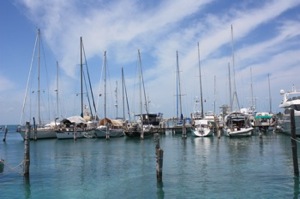
Here’s the story of our first check in, November 2004, Isla Mujeres, Mexico. Keep in mind, all countries change their procedures regularly and you never know from time to time what they will be, so there’s no getting comfortable with the process!
“After checking in to Marina Paraiso, we were told not to get off the boat, that “officialdom” will come to us at 3 PM. After waiting most of the day, the marina office informed us that the officials were not coming, and we should go to them the following morning. So David & I were illegal immigrants at dinner that night in Mexico, land of “manana”!
We learned quickly that manana does not mean tomorrow, it merely means, not today!
The next morning we did the Mexican Two Step, to get checked in. First we went to Migration (immigration), then to the Port Capitan who informed us that we had to get an agent to clear in. We politely smiled and asked directions even though this was not part of the process that were told by the marina. The cruisers in front of us got mad, veins standing out in his neck as he screamed obscenities at the port captain. His embarrassed crew had to physically drag him out of the office. Guess that’s my first experience with “ugly americans”, but it embarrassed me too and I used my poor spanish to apologize to the port captain.
After meandering around for a bit trying to follow directions, we found the agent at the island’s only gas station. We weren’t sure we really needed to use an agent – most countries allow you to check in and out yourselves without the added expense of an agent, but he spoke excellent English to explain what was happening, so we just went with the program. The agent took care of our boat import visa, our zarpe & other necessary paperwork. Note to those following in our wake: be sure to make up your crew list ahead of time & make zillions of copies, in Mexico they want 6 copies at each port you stop at & if you don’t have them, you have to walk someplace else to get copies made before you can do the Mexican Two Step!! This could be difficult at ports smaller than Isla Mujeres! Also make copies of your boat documentation papers & bill of sale.
We paid $124 US for all that stuff & then had to go to the bank for pay for our personal tourist cards-we asked for & got 180 days before we have to leave, we won’t stay that long, but just in case, we won’t have to redo the immigration part again until after 180 days. The bank cost another $40 US, so with everything it was $164 US. It took us all morning & we didn’t get back to the boat until 2 PM!
The boat import permit was another story entirely. Since we had plans to fly back to the US for Christmas, we had to have a “boat import permit”, but it was good for 10 years. The paperwork had to be sent to Cancun to the main office for reasons we never did grasp in our limited Spanish. When it returned a couple days later, it was all wrong and had to be totally redone. So I filled out all the paperwork again and the agent sent it off again. It’s now been a week in processing this paperwork – what if we weren’t planning to stay that long? Whatever. It seemed strange to be told to pick up the new boat import permit on Thanksgiving Day! So we watched some football at a local outside restaurant/bar and then reported to the agent’s office at the given time. Unfortunately, no one was there and the office was tightly locked. Asking around the gas station, we were told that he would return, so we waited … and waited… and waited.
Finally the official …. and our paperwork arrived. Only to be handed to us with the wrong expiration date. According to the date on the boat importation permit, our 10 year permit had already expired! Aaaarrrrggggg! Since we had no plans to return, we simply thanked the agent, took the permit and vamoosed! Later back at the boat, we changed the date year with a black pen to reflect the date it should have been … otherwise it would have had to go back to Cancun yet again and who knew how long that would take!
So after an entire week, we were sort of almost legal! Actually we had been legal since the 2nd day after we arrived, it was just the boat that wasn’t legal … on the other hand, we really didn’t want the boat confiscated by the authorities as could happen without it being legal!
As you can see, checking in to other countries is often a confusing maze. The most important thing to remember is that no matter what happens, keep smiling and treat it as a game. Just make sure at the end of the game that you ARE legal! 🙂 Above all, never ever lose your temper – it does no good whatsoever and will most likely delay the entire process. You are a guest in their country, it is a privilege not a right!
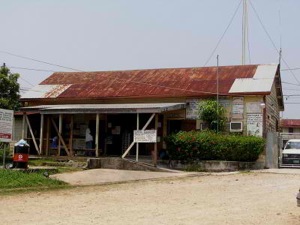
Check In Two Step
1. In general try not to check in or out of a major shipping port. Most of the officials there are accustomed to dealing with large ships and have no clue what to do with a sailboat. Often it will cost you more and be much more of a hassle to check in to a busy port. Avoid Belize City at all costs! Same with Cancun. I’ve never understood why cruisers go to either one when Isla Mujeres, Mexico and San Pedro, Belize are so close and are accustomed to sailboats and cruisers.
2. Always have multiple copies of your boat documentation, the photo page of your passports and your crew lists – in the language of the country you’re visiting.
3. Fly the yellow quarantine flag under the country courtesy flag from your starboard spreader as you enter a port.
4. Find out the latest information on checking in from other cruisers before you arrive at a port. Some ports don’t want you to leave the boat until officials visit you — and they can be mighty offended if you step ashore before they get there. Some ports expect you to dinghy in and head to the Port Captain’s office or Immigration immediately. Some expect you to use an agent, some don’t require it. Some don’t require it, but the process will be so much quicker and smoother if you do use an agent that it’s worth every dime. Know before you go!
5. Be flexible. Expect change and confusion and you won’t be disappointed! Some port captains refuse to renew your cruising permit a day before it expires (making it difficult in places where there’s no protected anchorage and a norther coming!), some will renew with no problem anytime. And sometimes the “rules” change with the cruiser – in fact, this is often the case.
6. Allow adequate time to get checked out given you may encounter a delay in getting to the correct officials.
7. Make sure that you know everything that has to be renewed. For example, in Belize, it must be unclear that you have to get both your personal immigration papers renewed every 30 days as well as your cruising permit. Some boaters didn’t realize they had to get their cruising permit renewed and it cost them a big fine! Don’t let this happen to you. In general even if officials tell you you don’t have to get something renewed, ask another official to confirm. And never take the word of immigration when you’re asking about something pertaining to a cruising permit, they may or may not know.
8. If you’re leaving your boat in longer than the countries cruising permit allows – this applied to us in the Rio Dulce as well as Panama – you will need to make sure that the permit can get renewed while you’re gone. In Panama, the marina handled all the details and in the Rio Dulce, our boat caretaker, also the marina manager, herself handled all the details. We just left the correct amount of money and voila, it happened! Don’t forget to make arrangements to get your cruising permit renewed!
Some specifics current as of the last time we were there:
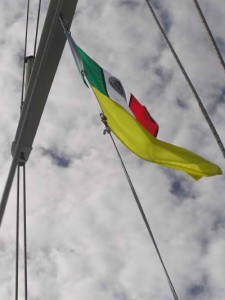
Belize – check in & out at Big Creek or San Pedro, Ambergris Caye, not Belize City. In general the Belizean officials expect you to arrive within a “reasonable” time of the date on your zarpe showing when you left the last port. They expect promptness and have been known to levy fines on “tardy” cruisers.
Rio Dulce – not sure with the security concerns what the procedure is these days. I do know that the best way to check in/check out is to use Raul Morales as your agent. Raul used to be the immigration officer and made everything easy, so wonderful. He no longer has that position, he changed to be an agent, but he will make your check in and out easy and painless. If you’re leaving your boat in the Rio, make sure you get him everything he needs to renew the cruising permit if required while you’re gone.
Honduras – if going to Roatan, do not try to anchor in Coxen Hole where the cruise ships and officials offices are, anchor in French Cay and take a cab or a collectivo to Coxen Hole. Or check in to Utila instead. But check to make sure the officials are there before going to Utila – often one of the officials will be in Utila, the other gone for a few weeks. They’ll check in either the boat or immigration and tell you to just check in with the other official when you arrive in Roatan. One of the most common QST’s on the NW Caribbean morning net is “does anyone know if the port captain or immigration are in Utila this week?”.
Providencia – Mr Bush will come to you, do not go ashore. You can call Mr Bush (the agent) on VHF 16 when you arrive. He’ll be watching from his office for yellow quarantine flags, so sometimes even if you don’t get him, he’ll find you.
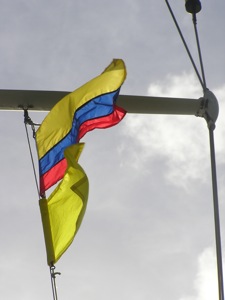
San Andreas – we used an agent – ask other cruisers for the best/most honest one as there are a few.
Bocas Del Toro & Shelter Bay, Panama – the officials came to the marina – the marinas arranged everything and told us exactly what to do, perfect! Only one time did we have to make a trip to Bocas Town or to Colon, but in both cases we knew exactly where we had to go and what we needed to do. Easy!
Cartagena, Columbia … when we were there, it was necesssary to use an agent. Our advice is to use the local agent, there were two when we were there and the German agent was OK, just slower it seemed than the local agent. I wish I could recall their names. This was the first place we were required to surrender our passports to the agent for overnight and we didn’t like it at all!
San Blas Islands, Porvenir, Panama – recognize that the San Blas are an independant “section” of Panama and may have different regulations. It can be a challenge to understand how to comply with both the Kuna Yala regulations and the Panamanian regulations, but I think this is getting better. Again, talk to those who are there currently. You will have to check in and renew at Porvenir, so plan accordingly.
Do you have a favorite check in/check out two step dance story? If so, please share by leaving a comment! THANKS! Jan
